[English] 日本語
 Yorodumi
Yorodumi- PDB-6x9c: Structure of proline utilization A with L-proline bound in the L-... -
+ Open data
Open data
- Basic information
Basic information
| Entry | Database: PDB / ID: 6x9c | ||||||
|---|---|---|---|---|---|---|---|
| Title | Structure of proline utilization A with L-proline bound in the L-glutamate-gamma-semialdehyde dehydrogenase active site | ||||||
 Components Components | Bifunctional protein PutA | ||||||
 Keywords Keywords | OXIDOREDUCTASE / FLAVOENZYME / ROSSMANN FOLD / PROLINE DEHYDROGNEASE / ALDEHYDE DEHYDROGENASE / PROLINE CATABOLISM / SUBSTRATE CHANNELING / BIFUNCTIONAL ENZYME | ||||||
| Function / homology |  Function and homology information Function and homology informationproline dehydrogenase / proline dehydrogenase activity / L-glutamate gamma-semialdehyde dehydrogenase / L-glutamate gamma-semialdehyde dehydrogenase activity / L-proline catabolic process to L-glutamate / : / cytoplasmic side of plasma membrane / DNA-binding transcription factor activity / nucleotide binding / DNA binding Similarity search - Function | ||||||
| Biological species |  Sinorhizobium meliloti (bacteria) Sinorhizobium meliloti (bacteria) | ||||||
| Method |  X-RAY DIFFRACTION / X-RAY DIFFRACTION /  SYNCHROTRON / SYNCHROTRON /  FOURIER SYNTHESIS / Resolution: 1.44 Å FOURIER SYNTHESIS / Resolution: 1.44 Å | ||||||
 Authors Authors | Tanner, J.J. / Campbell, A.C. | ||||||
| Funding support |  United States, 1items United States, 1items
| ||||||
 Citation Citation |  Journal: Arch.Biochem.Biophys. / Year: 2020 Journal: Arch.Biochem.Biophys. / Year: 2020Title: Structural analysis of prolines and hydroxyprolines binding to the l-glutamate-gamma-semialdehyde dehydrogenase active site of bifunctional proline utilization A. Authors: Campbell, A.C. / Bogner, A.N. / Mao, Y. / Becker, D.F. / Tanner, J.J. | ||||||
| History |
|
- Structure visualization
Structure visualization
| Structure viewer | Molecule:  Molmil Molmil Jmol/JSmol Jmol/JSmol |
|---|
- Downloads & links
Downloads & links
- Download
Download
| PDBx/mmCIF format |  6x9c.cif.gz 6x9c.cif.gz | 944.8 KB | Display |  PDBx/mmCIF format PDBx/mmCIF format |
|---|---|---|---|---|
| PDB format |  pdb6x9c.ent.gz pdb6x9c.ent.gz | 765.2 KB | Display |  PDB format PDB format |
| PDBx/mmJSON format |  6x9c.json.gz 6x9c.json.gz | Tree view |  PDBx/mmJSON format PDBx/mmJSON format | |
| Others |  Other downloads Other downloads |
-Validation report
| Summary document |  6x9c_validation.pdf.gz 6x9c_validation.pdf.gz | 2.9 MB | Display |  wwPDB validaton report wwPDB validaton report |
|---|---|---|---|---|
| Full document |  6x9c_full_validation.pdf.gz 6x9c_full_validation.pdf.gz | 2.9 MB | Display | |
| Data in XML |  6x9c_validation.xml.gz 6x9c_validation.xml.gz | 99.3 KB | Display | |
| Data in CIF |  6x9c_validation.cif.gz 6x9c_validation.cif.gz | 151.6 KB | Display | |
| Arichive directory |  https://data.pdbj.org/pub/pdb/validation_reports/x9/6x9c https://data.pdbj.org/pub/pdb/validation_reports/x9/6x9c ftp://data.pdbj.org/pub/pdb/validation_reports/x9/6x9c ftp://data.pdbj.org/pub/pdb/validation_reports/x9/6x9c | HTTPS FTP |
-Related structure data
| Related structure data |  6x99C 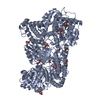 6x9aC  6x9bC  6x9dC 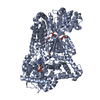 5kf6S S: Starting model for refinement C: citing same article ( |
|---|---|
| Similar structure data |
- Links
Links
- Assembly
Assembly
| Deposited unit | 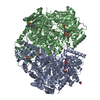
| ||||||||
|---|---|---|---|---|---|---|---|---|---|
| 1 | 
| ||||||||
| 2 | 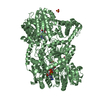
| ||||||||
| 3 |
| ||||||||
| Unit cell |
|
- Components
Components
-Protein , 1 types, 2 molecules AB
| #1: Protein | Mass: 131961.656 Da / Num. of mol.: 2 Source method: isolated from a genetically manipulated source Source: (gene. exp.)  Sinorhizobium meliloti (strain SM11) (bacteria) Sinorhizobium meliloti (strain SM11) (bacteria)Strain: SM11 / Gene: putA, SM11_chr0102 / Production host:  References: UniProt: F7X6I3, proline dehydrogenase, L-glutamate gamma-semialdehyde dehydrogenase |
|---|
-Non-polymers , 9 types, 2009 molecules 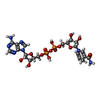

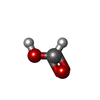



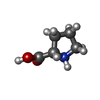
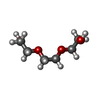









| #2: Chemical | | #3: Chemical | ChemComp-PEG / | #4: Chemical | ChemComp-FMT / | #5: Chemical | #6: Chemical | ChemComp-SO4 / #7: Chemical | #8: Chemical | #9: Chemical | ChemComp-PGE / | #10: Water | ChemComp-HOH / | |
|---|
-Details
| Has ligand of interest | Y |
|---|
-Experimental details
-Experiment
| Experiment | Method:  X-RAY DIFFRACTION / Number of used crystals: 1 X-RAY DIFFRACTION / Number of used crystals: 1 |
|---|
- Sample preparation
Sample preparation
| Crystal | Density Matthews: 2.39 Å3/Da / Density % sol: 48.47 % |
|---|---|
| Crystal grow | Temperature: 286 K / Method: vapor diffusion, sitting drop / pH: 8 Details: Crystallization experiments were set up with SmPutA (6 mg/mL) and NADH (10 mM) in a buffer containing 50 mM Tris (pH 8.0), 50 mM NaCl, 5% (w/v) glycerol, and 0.5 mM Tris(2-caboxyethyl) ...Details: Crystallization experiments were set up with SmPutA (6 mg/mL) and NADH (10 mM) in a buffer containing 50 mM Tris (pH 8.0), 50 mM NaCl, 5% (w/v) glycerol, and 0.5 mM Tris(2-caboxyethyl)phosphine. Crystals were grown using a reservoir solution containing 19% PEG-3350, 0.2 M ammonium sulfate, 0.1 M magnesium chloride, 0.1 M HEPES (pH 8.0), and 0.1 M sodium formate. Cryobuffer: reservoir supplemented with 15 % PEG-200 and 50 mM L-proline |
-Data collection
| Diffraction | Mean temperature: 100 K / Serial crystal experiment: N | ||||||||||||||||||||||||||||||
|---|---|---|---|---|---|---|---|---|---|---|---|---|---|---|---|---|---|---|---|---|---|---|---|---|---|---|---|---|---|---|---|
| Diffraction source | Source:  SYNCHROTRON / Site: SYNCHROTRON / Site:  ALS ALS  / Beamline: 4.2.2 / Wavelength: 1 Å / Beamline: 4.2.2 / Wavelength: 1 Å | ||||||||||||||||||||||||||||||
| Detector | Type: RDI CMOS_8M / Detector: CMOS / Date: Apr 26, 2018 | ||||||||||||||||||||||||||||||
| Radiation | Protocol: SINGLE WAVELENGTH / Monochromatic (M) / Laue (L): M / Scattering type: x-ray | ||||||||||||||||||||||||||||||
| Radiation wavelength | Wavelength: 1 Å / Relative weight: 1 | ||||||||||||||||||||||||||||||
| Reflection | Resolution: 1.44→48.463 Å / Num. obs: 412199 / % possible obs: 92.4 % / Redundancy: 3.6 % / CC1/2: 0.999 / Rmerge(I) obs: 0.059 / Rpim(I) all: 0.036 / Rrim(I) all: 0.069 / Net I/σ(I): 10.9 | ||||||||||||||||||||||||||||||
| Reflection shell | Diffraction-ID: 1
|
- Processing
Processing
| Software |
| ||||||||||||||||||||||||||||||||||||||||||||||||||||||||||||||||||||||||||||||||||||||||||||||||||||||||||||||||||||||||||||||||||||||||||||||||||||||||||||||||||||||||||||||||||||||||||
|---|---|---|---|---|---|---|---|---|---|---|---|---|---|---|---|---|---|---|---|---|---|---|---|---|---|---|---|---|---|---|---|---|---|---|---|---|---|---|---|---|---|---|---|---|---|---|---|---|---|---|---|---|---|---|---|---|---|---|---|---|---|---|---|---|---|---|---|---|---|---|---|---|---|---|---|---|---|---|---|---|---|---|---|---|---|---|---|---|---|---|---|---|---|---|---|---|---|---|---|---|---|---|---|---|---|---|---|---|---|---|---|---|---|---|---|---|---|---|---|---|---|---|---|---|---|---|---|---|---|---|---|---|---|---|---|---|---|---|---|---|---|---|---|---|---|---|---|---|---|---|---|---|---|---|---|---|---|---|---|---|---|---|---|---|---|---|---|---|---|---|---|---|---|---|---|---|---|---|---|---|---|---|---|---|---|---|---|
| Refinement | Method to determine structure:  FOURIER SYNTHESIS FOURIER SYNTHESISStarting model: 5kf6 Resolution: 1.44→48.46 Å / SU ML: 0.17 / Cross valid method: THROUGHOUT / σ(F): 0.31 / Phase error: 22.13 / Stereochemistry target values: ML
| ||||||||||||||||||||||||||||||||||||||||||||||||||||||||||||||||||||||||||||||||||||||||||||||||||||||||||||||||||||||||||||||||||||||||||||||||||||||||||||||||||||||||||||||||||||||||||
| Solvent computation | Shrinkage radii: 0.9 Å / VDW probe radii: 1.11 Å / Solvent model: FLAT BULK SOLVENT MODEL | ||||||||||||||||||||||||||||||||||||||||||||||||||||||||||||||||||||||||||||||||||||||||||||||||||||||||||||||||||||||||||||||||||||||||||||||||||||||||||||||||||||||||||||||||||||||||||
| Displacement parameters | Biso max: 77.09 Å2 / Biso mean: 25.7581 Å2 / Biso min: 7.72 Å2 | ||||||||||||||||||||||||||||||||||||||||||||||||||||||||||||||||||||||||||||||||||||||||||||||||||||||||||||||||||||||||||||||||||||||||||||||||||||||||||||||||||||||||||||||||||||||||||
| Refinement step | Cycle: final / Resolution: 1.44→48.46 Å
| ||||||||||||||||||||||||||||||||||||||||||||||||||||||||||||||||||||||||||||||||||||||||||||||||||||||||||||||||||||||||||||||||||||||||||||||||||||||||||||||||||||||||||||||||||||||||||
| LS refinement shell | Refine-ID: X-RAY DIFFRACTION / Rfactor Rfree error: 0
| ||||||||||||||||||||||||||||||||||||||||||||||||||||||||||||||||||||||||||||||||||||||||||||||||||||||||||||||||||||||||||||||||||||||||||||||||||||||||||||||||||||||||||||||||||||||||||
| Refinement TLS params. | Method: refined / Refine-ID: X-RAY DIFFRACTION
| ||||||||||||||||||||||||||||||||||||||||||||||||||||||||||||||||||||||||||||||||||||||||||||||||||||||||||||||||||||||||||||||||||||||||||||||||||||||||||||||||||||||||||||||||||||||||||
| Refinement TLS group |
|
 Movie
Movie Controller
Controller



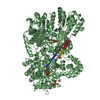








 PDBj
PDBj












